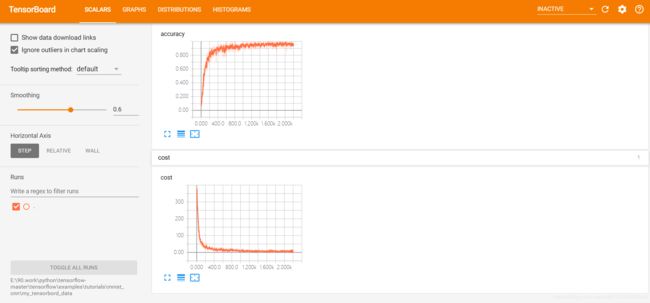【深度学习入门项目】MNIST
官方Demo:https://www.w3cschool.cn/tensorflow_python/tensorflow_python-vj8528sp.html
1、源码
基于官方Demo增加注释和个人理解,增加tensorboard数据存储。
# Import the deep learning library
import tensorflow as tf
import time
#import input_data
#mnist = input_data.read_data_sets('MNIST_data', one_hot=True)
from tensorflow.examples.tutorials.mnist import input_data
mnist = input_data.read_data_sets("/tmp/data/", one_hot=True)
# placeholder:插入占位符
# 函数定义:placeholder(dtype, shape=None, name=None)
x = tf.placeholder("float", shape=[None, 784])
y_ = tf.placeholder("float", shape=[None, 10])
# tf.truncated_normal(shape, mean, stddev) :shape表示生成张量的维度,mean是均值,stddev是标准差。
# 这个函数产生正太分布,均值和标准差自己设定。
def weight_variable(shape):
with tf.variable_scope("var_weight"):
initial = tf.truncated_normal(shape, stddev=0.1)
var_weight = tf.Variable(initial)
tf.summary.histogram('var_weight',var_weight)
return var_weight
# tf.constant 创建一个常数张量,传入list或者数值来填充
def bias_variable(shape):
with tf.variable_scope("var_bias"):
initial = tf.constant(0.1, shape=shape)
var_bias = tf.Variable(initial)
tf.summary.histogram('var_bias',var_bias)
return var_bias
'''
函数名:tf.nn.conv2d(input, filter, strides, padding, use_cudnn_on_gpu=None, name=None)
函数说明:除去name参数用以指定该操作的name,与方法有关的一共五个参数:
第一个参数input:指需要做卷积的输入图像,它要求是一个Tensor,
具有[batch, in_height, in_width, in_channels]这样的shape,
具体含义是[训练时一个batch的图片数量, 图片高度, 图片宽度, 图像通道数],注意这是一个4维的Tensor,
要求类型为float32和float64其中之一
第二个参数filter:相当于CNN中的卷积核,它要求是一个Tensor,
具有[filter_height, filter_width, in_channels, out_channels]这样的shape,
具体含义是[卷积核的高度,卷积核的宽度,图像通道数,卷积核个数],要求类型与参数input相同,有一个地方需要注意,第三维in_channels,就是参数input的第四维
第三个参数strides:卷积时在图像每一维的步长,这是一个一维的向量,长度4
第四个参数padding:string类型的量,只能是"SAME","VALID"其中之一,这个值决定了不同的卷积方式(后面会介绍)
第五个参数:use_cudnn_on_gpu:bool类型,是否使用cudnn加速,默认为true
结果返回一个Tensor,这个输出,就是我们常说的feature map,shape仍然是[batch, height, width, channels]这种形式。
函数名:tf.nn.bias_add( value,bias, name=None)
函数说明:将偏差项bias加到value上面
'''
def conv2d(x, W):
return tf.nn.conv2d(x, W, strides=[1, 1, 1, 1], padding='SAME')
'''
函数名:tf.nn.max_pool(value, ksize, strides, padding, name=None)
函数说明:
第一个参数value:需要池化的输入,一般池化层接在卷积层后面,
所以输入通常是feature map,依然是[batch, height, width, channels]这样的shape
第二个参数ksize:池化窗口的大小,取一个四维向量,
一般是[1, height, width, 1],因为我们不想在batch和channels上做池化,所以这两个维度设为了1
第三个参数strides:和卷积类似,窗口在每一个维度上滑动的步长,一般也是[1, stride,stride, 1]
第四个参数padding:和卷积类似,可以取'VALID' 或者'SAME'
返回一个Tensor,类型不变,shape仍然是[batch, height, width, channels]这种形式
'''
def max_pool_2x2(x):
return tf.nn.max_pool(x, ksize=[1, 2, 2, 1],
strides=[1, 2, 2, 1], padding='SAME')
W_conv1 = weight_variable([5, 5, 1, 32])
b_conv1 = bias_variable([32])
x_image = tf.reshape(x, [-1,28,28,1])
'''
函数名:tf.nn.relu(features, name = None)
函数说明:这个函数的作用是计算激活函数 relu,即 max(features, 0)。即将矩阵中每行的非最大值置0。
'''
h_conv1 = tf.nn.relu(conv2d(x_image, W_conv1) + b_conv1)
h_pool1 = max_pool_2x2(h_conv1)
W_conv2 = weight_variable([5, 5, 32, 64])
b_conv2 = bias_variable([64])
h_conv2 = tf.nn.relu(conv2d(h_pool1, W_conv2) + b_conv2)
h_pool2 = max_pool_2x2(h_conv2)
W_fc1 = weight_variable([7 * 7 * 64, 1024])
b_fc1 = bias_variable([1024])
h_pool2_flat = tf.reshape(h_pool2, [-1, 7*7*64])
'''
函数名:matmul(a,b,transpose_a=False,transpose_b=False,adjoint_a=False,
adjoint_b=False,a_is_sparse=False,b_is_sparse=False,name=None)
函数说明:将矩阵 a 乘以矩阵 b,生成a * b
函数名:add(x, y, name=None)
函数说明:这个函数是使x,和y两个参数的元素相加,返回的tensor数据类型和x的数据类型相同
'''
h_fc1 = tf.nn.relu(tf.matmul(h_pool2_flat, W_fc1) + b_fc1)
# tf.nn.dropout()是tensorflow里面为了防止或减轻过拟合而使用的函数,它一般用在全连接层
keep_prob = tf.placeholder("float")
h_fc1_drop = tf.nn.dropout(h_fc1, keep_prob)
W_fc2 = weight_variable([1024, 10])
b_fc2 = bias_variable([10])
'''
函数名:tf.nn.softmax(logits,axis=None,name=None,dim=None)
函数说明:计算softmax激活。
'''
y_conv=tf.nn.softmax(tf.matmul(h_fc1_drop, W_fc2) + b_fc2)
'''
函数名:
tf.nn.softmax_cross_entropy_with_logits(_sentinel=None,labels=None,
logits=None,dim=-1,name=None)
函数说明:计算logits和labels之间的softmax交叉熵
函数名:
reduce_mean(input_tensor,axis=None,keep_dims=False,name=None,reduction_indices=None)
函数说明:计算张量的各个维度上的元素的平均值.
'''
# 损失函数是目标类别和预测类别之间的交叉熵.
# 注意,tf.reduce_sum把minibatch里的每张图片的交叉熵值都加起来了.我们计算的交叉熵是指整个minibatch的.
cross_entropy = -tf.reduce_sum(y_*tf.log(y_conv))
'''
函数名:
tf.train.AdamOptimizer(learning_rate=0.001, beta1=0.9, beta2=0.999,
epsilon=1e-08, use_locking=False, name='Adam')
函数说明:
此函数是Adam优化算法:是一个寻找全局最优点的优化算法,引入了二次方梯度校正。
相比于基础SGD算法,1.不容易陷于局部优点。2.速度更快
'''
# 用梯度下降算法(gradient descent algorithm)以0.01的学习速率最小化交叉熵
train_step = tf.train.AdamOptimizer(1e-4).minimize(cross_entropy)
'''
函数名:tf.argmax(input,axis)
函数说明:tf.argmax(input,axis)根据axis取值的不同返回每行或者每列最大值的索引。
axis=0的时候,比较每一列的元素,将每一列最大元素所在的索引记录下来,最后输出每一列最大元素所在的索引数组。
axis=1的时候,将每一行最大元素所在的索引记录下来,最后返回每一行最大元素所在的索引数组。
函数名:tf.equal(A, B)
函数说明:tf.equal(A, B)是对比这两个矩阵或者向量的相等的元素,
如果是相等的那就返回True,反正返回False,返回的值的矩阵维度和A是一样的
函数名:tf.cast(x,dtype,name=None)
函数说明:将x的数据格式转化成dtype
'''
correct_prediction = tf.equal(tf.argmax(y_conv,1), tf.argmax(y_,1))
# accuracy准确度
accuracy = tf.reduce_mean(tf.cast(correct_prediction, "float"))
'''
函数名:tf.summary.scalar(tags, values, collections=None, name=None)
函数说明:用来显示标量信息
函数名:tf.summary.merge(inputs,collections=None,name=None)
函数说明:合并标量信息
'''
cost = tf.summary.scalar("cost", cross_entropy)
training_accuracy = tf.summary.scalar("accuracy", accuracy)
#train_summary_merge = tf.summary.merge([cost,training_accuracy])
train_summary_merge = tf.summary.merge_all()
'''
batch是一个二维向量,包含50个训练数据信息
batch[0] 训练数据图片,sharp :(50,784)
batch[1] 训练数据答案,sharp : (50,10)
'''
'''
tensor.eval()的意义和sess.run()一样,t.eval()等效于sess.run(t).
但是二者也有些微区别:run可以同时运行多个tensor;t.eval() 运行必须包含在默认的sess之内
'''
with tf.Session() as sess:
'''
函数名:tf.global_variables_initializer()
函数说明:初始化模型参数
'''
sess.run(tf.global_variables_initializer())
'''
函数名:tf.summary.FileWriter(self,logdir,graph=None,max_queue=10,flush_secs=120,graph_def=None)
函数说明:将汇总结果写入事件
'''
train_writer = tf.summary.FileWriter("./my_tensorbord_data", sess.graph)
for i in range(20000):
batch = mnist.train.next_batch(50)
if i%100 == 0:
# 在feed_dict中加入额外的参数keep_prob来控制 dropout 比例
train_accuracy = accuracy.eval(feed_dict={
x:batch[0], y_: batch[1], keep_prob: 1.0})
print ("step %d, training accuracy %g " % (i,train_accuracy))
summary, result = sess.run([train_summary_merge,train_step],feed_dict={x: batch[0], y_: batch[1], keep_prob: 0.5})
train_writer.add_summary(summary, i)
print ("test accuracy %g"%accuracy.eval(feed_dict={
x: mnist.test.images, y_: mnist.test.labels, keep_prob: 1.0}))
2、计算图
3、准确率和损失率
电脑太挫,训练了将近2小时,测试数据准确率达99%。

